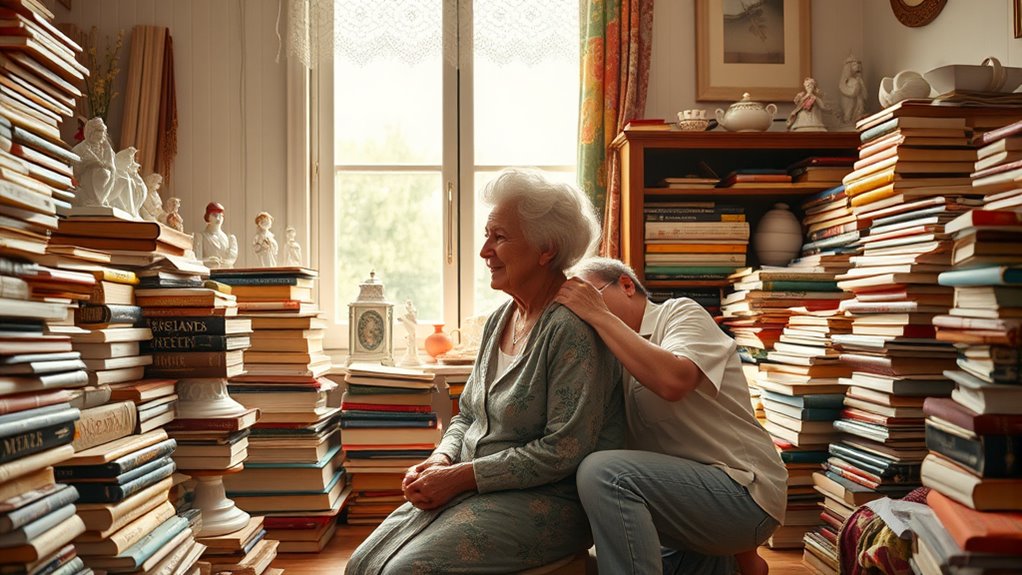When helping a senior who hoards, approach with patience, empathy, and respect for their emotional attachments. Focus on small, manageable steps, like sorting one drawer at a time, and listen to their stories about possessions. Explain safety risks gently and suggest preserving memories in photos or books. Remember, the goal is to create a safe, comfortable space without dismissing their feelings. If you want insights on compassionate ways to support them further, keep exploring these strategies.
Key Takeaways
- Approach decluttering gradually, respecting the senior’s emotional attachments and involving them in decision-making processes.
- Communicate safety concerns gently, explaining how clutter can pose health and emergency risks without dismissing their feelings.
- Use supportive tools like photographs or memory books to preserve meaningful items while reducing physical clutter.
- Practice patience and active listening to foster trust and create a positive, collaborative environment during decluttering.
- Emphasize that organizing their space enhances safety and well-being, reinforcing the benefits of a clean, comfortable home.

Are you feeling overwhelmed by clutter in your home? When you’re helping a senior who hoards, it’s easy to feel frustrated or helpless, but understanding their perspective is key. Many seniors develop emotional attachments to their belongings, often viewing these items as symbols of memories, safety, or even identity. This emotional attachment can make it incredibly difficult for them to let go, even when the clutter poses safety concerns or hampers daily life. Recognizing that these possessions aren’t just objects but hold deep personal significance helps you approach the situation with empathy rather than judgment.
Safety concerns are often the most urgent reason to address clutter. Excessive piles of belongings can block exits, create tripping hazards, or make it difficult for emergency responders to access the home. You might notice that pathways are narrow or that clutter is stacked dangerously high, increasing the risk of falls or injuries. It’s essential to gently communicate these concerns to your loved one, emphasizing safety without dismissing their feelings. Reassure them that your goal isn’t to take away everything they cherish but to create a space that’s secure and comfortable. Additionally, understanding types of clutter can help you identify which items pose the greatest risks and develop targeted strategies for decluttering. Recognizing emotional attachments can also help you approach the process with greater sensitivity and patience.
Address safety risks by gently highlighting blocked exits and tripping hazards, emphasizing care without dismissing their feelings.
When you start the decluttering process, patience is your best tool. Instead of insisting on immediate removal, try to engage your senior in small, manageable steps. For example, encourage sorting through a single drawer or shelf at a time. During this process, listen actively to their stories about specific possessions. This shows respect for their emotional attachment and can make them more willing to part with items they no longer need or that are causing safety hazards. Remember, it’s not about discarding everything but about making thoughtful decisions together. Sometimes, sharing detailed explanations about safety risks can help them understand the importance of decluttering for their well-being. Incorporating professional help or community resources can also provide additional support and guidance through the process.
Offer practical solutions that acknowledge their feelings. For items with sentimental value, suggest taking photographs or creating memory books. This way, they preserve the memories without needing to keep every physical object. If certain possessions are no longer useful or safe, gently explain that letting go can actually help protect their health and well-being. Additionally, educating yourself about various types of clutter can provide insights into effective decluttering strategies and emotional support options. Reinforce that decluttering isn’t about erasing their history but about ensuring they remain safe and comfortable in their home.
Ultimately, your compassion and understanding will help your loved one feel supported rather than pressured. By respecting their emotional attachment and addressing safety concerns delicately, you can guide them toward a clutter-free space that feels both meaningful and secure. Your patience and empathy can make a significant difference in transforming a stressful situation into a positive experience for everyone involved.
Frequently Asked Questions
How Do I Start a Decluttering Conversation With a Senior?
When starting a decluttering conversation, you should use gentle communication to show respect and understanding. Begin by expressing concern with kindness, focusing on your care for their well-being. Build empathy by listening carefully, avoiding judgment, and acknowledging their feelings. Frame the conversation as a team effort to improve their comfort and safety, making it clear you’re there to support them every step of the way.
What Emotional Support Techniques Are Effective During Decluttering?
Imagine offering a warm embrace through words—emotional validation and gentle encouragement work wonders. You can acknowledge their feelings without judgment, saying things like, “I see how much this means to you,” to validate emotions. Use calm, reassuring tones, listen patiently, and remind them they’re not alone. These techniques help create a safe space, making decluttering less stressful and more manageable, fostering trust and emotional well-being.
How Can I Ensure Safety During the Decluttering Process?
To guarantee safety during decluttering, you should follow safety precautions like wearing gloves and sturdy shoes, and use appropriate decluttering tools such as grabbers, gloves, and masks. Keep pathways clear to prevent trips and falls, and avoid lifting heavy items alone. Regularly check for sharp objects or hazardous materials, and take breaks to avoid fatigue. These steps help create a safe environment while decluttering.
What Community Resources Assist With Senior Hoarding Issues?
You should explore local support options that address senior hoarding issues, focusing on mental health. Community resources like senior centers, mental health clinics, and social services often offer counseling and specialized programs to help seniors manage clutter. These services can provide emotional support, practical guidance, and connections to professionals who understand hoarding behaviors, ensuring your loved one receives compassionate, effective assistance tailored to their needs.
How Do I Handle Resistance From the Senior During Decluttering?
Handling resistance can feel like trying to move a mountain, but with motivational strategies, you can gently break down barriers. Use empathy building to connect emotionally, showing understanding rather than judgment. Listen actively, validate their feelings, and share small, achievable goals. This approach helps the senior feel respected and empowered, making decluttering less intimidating and more collaborative. Patience and kindness turn resistance into cooperation over time.
Conclusion
As you gently guide your loved one through their cluttered world, imagine a clear, open space unfolding before you—bright sunlight streaming through windows, fresh air filling the room. With patience and compassion, you help transform chaos into calm, turning cluttered corners into peaceful havens. Each small step lights the way to a lighter, more comfortable life, where memories are cherished but not trapped. Together, you create a space filled with hope, warmth, and renewed possibilities.









